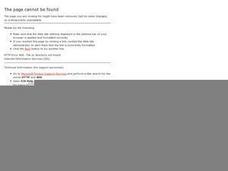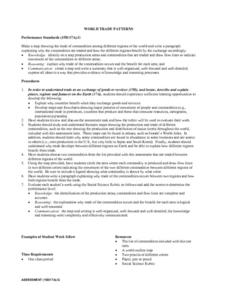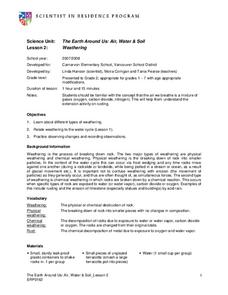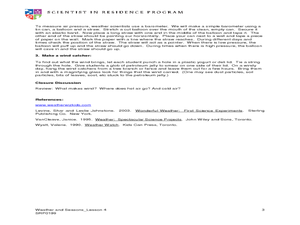Curated OER
Deer Tracks
Students use satellite images to track to movement patterns of deer and examine deer behavior. They write stories about a day in the life of a field scientist.
Curated OER
Economics: World Trade Patterns
Students examine world trade patterns and discover the role of commodities in trade. While explaining the benefits of trade, they create maps and flowcharts depicting the patterns of goods and people movement. Also, students write...
Curated OER
Collecting Electromagnetic Radiation
Students using different experiments and activities explore electromagnetic radiation and the effect on the Earth.
Curated OER
Peru's Earthquake
Students identify the patterns of earthquakes by mapping USGS data and comparing it to mapped tectonic plates. They discover the relationship between earthquakes and the moving plates of the Earth's crust.
Curated OER
Environmental Destruction in Vietnam
Students watch video clip on Environmental Destruction of Vietnam, select and discuss passages from essay, Resuscitation of the Dead Earth, that emphasize destruction to the land, and write essay on whether United States should have been...
Curated OER
Keeping Warm
Young scholars place words describing a range from cold to hot on a scale. Using those words, they identify places on Earth which are cold, hot, freezing or boiling. They practice using and reading a thermometer with three different...
Curated OER
Civil War in Vietnam
Learners view and discuss Powerpoint presentation on Vietnamese Conflict, read essay, Resuscitation of the Dead Earth, review vocabulary, and answer critical thinking questions as a class.
Curated OER
Plate Tectonics And Convection Currents
Students observe the currents that occur through convection in water and relate them to the currents in molten rock in the Earth's mantle. They set up a convection current in a cake pan of water using a bag of ice on one end and an...
Science Matters
Earthquakes and Volcanoes Post Assessment
The final lesson in the 20-part series is a post assessment covering earthquakes and volcanoes. Twenty-three questions incorporate each of the previous lessons through multiple choice, justified multiple choice, expanded multiple choice,...
Science Matters
A Model of Plate Faults
The San Andreas fault is one of the longest fault zones in the world. In a series of 20 lessons, the fourth lesson has pupils use a paper model to recreate various types of plate faults. Each is held in position then drawn...
Curated OER
What is Air?
Students investigate air by participating in a class experiment. For this matter measurement lesson, students identify air as a gas which consists of mass. Students utilize a windsock or balloon to measure oxygen and explore it's true...
Science Matters
Earthquakes and Volcanoes Pre-Assessment
See how much your class knows about earthquakes and volcanic activity and how these events shape geologic features. The first lesson in the series of 20 is a pre-test to find out what pupils already know. It includes 10 vocabulary...
Curated OER
Outlining Transportation#139
Students examine how people, products, and ideas travel. They create an outline using the proper format after completing a class brainstorming session about means of transportation.
Curated OER
Where's the Beach?
Students use beach profile data to analyze how erosion and sediment transport changed seashore slopes. In this geology instructional activity, students plot the data provided and analyze erosion patterns. They also assess coastal erosion...
Curated OER
What is the Rock Cycle and Its Processes?
Geology beginners examine three different rock samples and determine their origin by their characteristics. By making and recording observations, they become familiar with features of igneous, metamorphic, and sedimentary rock types....
Curated OER
Glaciers Worksheet #2
A map of the Hudson River Valley is exhibited here. Arrows representing glacial striations are spread across the map for learners to analyze. They answer five multiple choice questions in response. The worksheet is a compact review of...
Curated OER
Weathering
Second graders explore weathering and how the water cycle plays a part in weathering. In this weathering lesson, 2nd graders put gravel and sugar cubes in a jar and shake, simulating weathering. Students use the scientific method to...
Curated OER
Water filtration with Plants
Sixth graders explain how soil and plants effect contaminated water in nature. In this filtration instructional activity, 6th graders work in groups to test biofiltration units. Students determine which biofiltration units work...
Curated OER
Glaciers Worksheet #1
The landscape impacted by glacier activity is drawn at the top of this activity. Ten multiple choice questions follow, some relating to the diagram, and some about the quality of soil left by glaciation. It is not often that you come...
Curated OER
Science: What Is the Carbon Cycle?
Students examine the carbon cycle while identifying its sources, sinks, and release agents. Using magazines and newspapers, groups of students design collages illustrating the carbon cycle. Finally, they write responses to several...
Curated OER
Wind and Air Pressure
Students make an anemometer, barometer, and wind catcher to see how wind and air pressure are related. In this wind lesson plan, students use these tools to measure the wind speed.
Michigan Sea Grant
Exploring Watersheds
Collaboratively, students partake in a hands-on activity in which they build models of a watershed. Each group member draws an elevation map—a bird's eye view—of their model and predicts how water will flow from the high to low points....
Science 4 Inquiry
Edible Plate Tectonics
Many people think they can't observe plate tectonics, but thanks to GPS, we know that Australia moves at a rate of 2.7 inches per year, North America at 1 inches per year, and the Pacific plate at more than 3 inches per year! Scholars...
Forest Foundation
Forests, Carbon & Our Climate
To conclude their examination of forest ecosystems, class members consider the role forests play in the carbon cycle and how forests can offset climate change.
